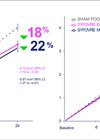Central geographic atrophy (GA) is one of the morphological sub types of late-stage macular degeneration. The natural course of the disease is characterised by expanding areas of macular atrophy, which cause absolute scotoma. Fundus autofluorescence (FAF) is derived from lipofuscin (LF) in the retinal pigment epithelium (RPE). This study was designed to investigate whether areas of increased autofluorescence (AF) surrounding the atrophic patches are associated with GA enlargement with time. Fifty-four eyes of 35 patients with GA were included in the study. Areas of GA were quantified by RegionFinder software. They concluded that areas with diffuse trickling (median 1.42mm2 / year) and banded patterns (0.81mm2 / year) might have an impact on progression. The group with baseline total atrophic of the eyes <1disc area (DA; median 0.42mm2) had an inverse relation with GA progression compared to the groups with baseline atrophy >1 disc area (p<0.05).




